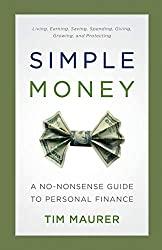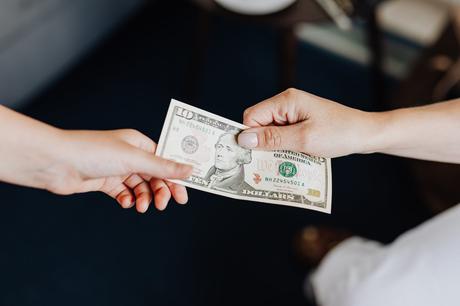
Chocolate Fondue
Tipping is largely an American practice. Servers in Europe are paid more in their regular paycheck and as a result customers generally only tip a small amount, and then only if the service is exceptional. In either case, the customer is the one paying the money, either directly as a tip or in a higher bill. Of course, I’ve got to believe that European servers who see American tourists coming are hopeful that they don’t know this so that they’ll leave an American-sized tip on top of an already inflated bill.
(Note, if you click on a link in this post and buy something from Amazon (even if you buy something different from where the link takes you), The Small Investor will receive a small commission from your purchase. This costs you nothing extra and is the way that we at The Small Investor are repaid for our hard work, bringing you this great content. It is a win-win for both of us since it keeps great advice coming to you (for free) and helps put food on the table for us. If you don’t want to buy something from Amazon or buy a book, how about at least telling your friends and family about our website as a great place to learn about investing and personal finance. Thanks!)
Why we tip
I’ve heard (but can’t confirm) that “tips” is actually an acronym that stands for “To Insure Proper Service.” I doubt that this is true, first because the word “insure” should be “ensure” and because I’m doubtful that acronyms were in wide use at the time the term, “tipping,” was coined. (OK, people were writing everything longhand using quill pens or maybe chiseling into rocks at the time, so maybe acronyms were in use to save writing.) The acronym is appropriate in any case, at least for tips as they have been used traditionally in America. A tip is meant as an incentive to provide good service.
Really, a tip is meant to pay for the service portion of the meal. It is separate from regular pay because the customer is supposed to have control over how large it is based on the service received. Somewhere along the way it became a percentage of the cost of the meal, which makes sense in some respects since a restaurant that charges $30 per plate is probably providing better service than one charging $5 per plate (I’ve seen a few high-end places that rake the bread crumbs off of the table with a little comb between courses), but a lot of times servers at nice places may not really provide service that is worthy of the amount received, while those at diners and low-end restaurants might be killing themselves for a dollar tip. (My sister, who worked for a time at Denny’s on an overnight shift, would say that the worst and most demanding customers were those who would just have coffee, sitting there for hours, complaining about everything. After a couple of hours of coffee refills, they would normally just leave her the change from the dollar they would leave to pay for the coffee!)
PrettyLitter is dust-free, advanced odor control, health-monitoring cat litter. Our color changing crystal litter helps to detect your cat’s health issues early. Its highly absorbent silica gel crystals absorb moisture and trap odor.

Before minimum wage laws, some people agreed to work at an establishment just for tips. The restaurant or bar owner could not afford to pay for servers because he/she knew that the diners would not be willing to pay extra for the food when they could go next door and pay less for the same thing, but servers knew that they could make a good living just on tips if they did a good job serving. The owner knew that providing servers would enhance the customer experience, however, perhaps drawing in customers from the other places who didn’t offer service. If it didn’t work, at least he/she wasn’t out the cost of the servers. If it did, the customers would take care of paying the servers and the owner would be paid for providing the food, tables, dishware, and room. Again, the customers were the ones paying for everything in either case, whether they paid the servers directly through a tip or if they paid the owner who paid the server.
Note that Americans probably don’t do tipping the right way to get the effect desired. Really, we should be tipping ahead of time to let the server know that they are going to receive a fair tip before the meal starts so he or she knows he isn’t going to go all out and then get stiffed. To really do it right, particularly at a nice place where you’re expecting to leave $20 or more as a tip, you should subtly slip your minimum tip into the server’s hand at the start (giving the host or Maître D a tip as well doesn’t hurt). You should then add to the tip at the end based on the quality of service. So, you might give the server $10 as you’re seated, then add another $10 to $15 when with the check.
Have a good job but don’t seem to have money to invest? You need to learn how to take control of your cash flow and free up funds for investing. FIREd by Fifty: How to Create the Cash Flow You Need to Retire Early gives all of the details on how you can build a cash flow plan and free up money to build wealth.

How much should you tip
I’ve noticed that this question is often answered by either servers or social justice advocates when placed on line. I’ve also noticed that tip percentages have increased since this started from where they have been. Of course, they also were higher in my lifetime than they were in my parent’s generation, so it appears that tip inflation should be expected. One also needs to wonder how much people actually tip and what servers say they want people to tip. If those tipping are leaving 30%, but only half of people are tipping, that doesn’t mean that tips should be 30%. Those who aren’t tipping should pick up their share.
Traditionally a tip has been 15% of the bill, before tax is added. This is difficult for some people to calculate in their head, but can be done fairly easily by 1.) Calculating 10% by slinding the decimal point to the right one space and then determining half of that and adding or 2.) Doubling the sales tax in states where it is around 7-8%. For example, if the bill is $18.24, 10% is $1.82, then half of that is $0.91, so 15% would be $2.73. Note that some places will provide estimates for tips for you on the receipt, but they sometimes figure the tip after tax is included, so you’re actually tipping a higher percentage if you use these a lot of the time.
I will always round up my tip to the next dollar amount, even when using a credit card, so I would have left $3.00 in the example above. I will also leave at least $2 everywhere, since while $0.75 might be 15% of a $5 meal, what can someone buy with $0.75? Also, if you have a coupon, part of your meal has been comped, or it is happy hour and there are drink specials reducing your bill, you should tip on what you would have paid without the discounts. The server still had to do the same amount of work even though you paid less.
If the service is standard, which means taking the order in a reasonable amount of time, bringing the food, and then bringing and taking care of the check reasonably soon after the meal, I’ll leave 15%, rounded up. If there is something done really wrong, where I get aggravated, I’ll drop this to 10%. I generally don’t do this if it seems to be something beyond the server’s control and not for minor things, but I will for big things. Examples would be a ten minute wait before they ever show up at my table, forgetting to give me silverware and then not checking on me for several minutes, such that the food is cold before I can eat, or disappearing for twenty minutes when I’m ready to get the check and leave.



Shop Personal Finance and Business Books
If the service is outstanding, where the server made my experience better and went beyond the standard, I’ll tip 20% rounded up or more. I’ll also tip 20% or more if the server was required to do a lot more than just the standard. One example might be a buffet where the server needs to come to the table seven or eight times during the mean to clear plates along with bringing drink refills. If I leave a bigger mess than standard, for example back when I was eating with a six month-old, I would leave a bigger tip as well (after helping to clean up some of the additional mess myself).

Photo by Karolina Grabowska on Pexels.com
" data-orig-size="1880,1253" data-image-title="pexels-photo-4968382.jpeg" data-orig-file="https://smallivy.files.wordpress.com/2021/12/pexels-photo-4968382.jpeg" data-image-description="" data-image-meta="{"aperture":"0","credit":"","camera":"","caption":"","created_timestamp":"0","copyright":"","focal_length":"0","iso":"0","shutter_speed":"0","title":"","orientation":"0"}" data-medium-file="https://smallivy.files.wordpress.com/2021/12/pexels-photo-4968382.jpeg?w=300" data-permalink="https://smallivy.com/2021/12/31/tipping-from-the-customer-perspective/pexels-photo-4968382/" alt="" class="wp-image-21398" data-large-file="https://smallivy.files.wordpress.com/2021/12/pexels-photo-4968382.jpeg?w=723" />Photo by Karolina Grabowska on Pexels.com
The morality behind tipping
The social justice and socialist crowds have tried to make tipping a moral imperative based on the needs of the server. You’ll hear people say or write that “they don’t get paid a lot, and it is hard to make ends meet” or “they really need the money, so even if the service is bad, I still leave a big tip.” This is conflating tipping with charity. I find this to both be manipulative for the customer and insulating.
It is not the customer’s responsibility to provide the rent for the server. The number of children or size of the student loans that the server has is also not the customer’s concern. He/she is simply paying for the service provided and should pay an appropriate amount. Should the customer ask about the server’s living and financial situation before leaving a tip? If the server is a teen-ager working a summer job, driving the Jaguar his parents gave him into work each day, should he receive a lower tip of nothing at all? Do you pay more at Walmart than your bill because there may be a stockholder somewhere who needs to make a rent payment?
It is also really insulting to your servers to think this way. He or she is not asking for a hand-out. Your servers are working a job, providing a service to you. This is no different than anyone else who provides a service. Yes, the server normally does so because he or she needs to pay rent and buy food, but that is the reason most anyone works any job. Just because you have a say in how much is provided does not mean that you are obligated to give an oversized amount. The server is providing a service, which is an dignified and respectable thing to do, in exchange for compensation suitable for the work provided.
To turn it into charity robs the dignity of the job and is unfair. To give more than deserved to a server who does a bad job is unfair to the server doing a great job who receives the same. And to treat it like charity because you think you’re so important because of your job and they’re so lowly because of their jobs is arrogant and condescending. Get over yourself.
That said, you are morally required to provide a suitable tip for the service provided. Just as you wouldn’t walk into a store and just take something without paying for it (OK, maybe some people would, in this day and age), if you use an establishment where employees who are tipped provide you with services, you are required to tip. By sitting down at that table and putting your order in, you are agreeing to provide a tip based on the service provided. If you don’t want to do this, cook at home or go to a place where there is no service to eat.
If you want to learn about individual stock investing, SmallIvy Book of Investing: Book 1: Investing to Become Wealthy is an excellent source of information. It provides information on many forms of investments, a strategy for investing that puts the odds way into your favor, and some tips on how you should be investing and managing your money during different stages of your life. The book provides a lot of the information you’ll need to know to do well in stock investing.

How to increase your tips
I’m sure that good servers can add other tips based on their experience, which I hope they will do in the comment section. As a customer, there are several things that will cause me to increase my tip. Really, I’m surprised in general how bad many servers are, given that a substantial portion of their pay is discretionary for the customer. I’ve asked friends before who have worked as servers whether the issue is that customers in general tip about the same whether you do a great job or a terrible job, thinking that might be the issue, but they’ve said that no, tips tend to increase if you do a good job. So the mystery remains. I guess that some people are just bad servers/don’t care or are really clueless.
As I’ve said above, I’ll provide the standard tip, which will be around 15%, if the server provides standard service. This means the server gets the order relatively soon after I sit down, brings the food when it’s ready and hot, checks on things right after the food comes (in case anything like ketchup or silverware is needed, or in case the order is wrong) if there is a food runner, refills drinks relatively consistently, and then brings and takes up the check soon after I’m done eating. I’ll tend to tip a higher percentage if this is all done well at a lower-end place and I won’t leave less than $2 anywhere. If there are big issues that degrade my experience, I may cut this a bit.
I will cut the tip if service is bad because the restaurant is really busy and the server rarely shows up because I’m not getting the 15% level of service. I know that it is not the server’s fault that the restaurant is busy, but if a server is waiting on eight tables instead of the normal four because they are short staffed and therefore abandons me for most of the meal, it means he or she also have eight tables providing tips instead of four, which makes up for lower average tips. Now, if the server is phenomenal and can provide the same, great level of service to more tables at a time, he or she should get more money in tips.
I will tip extra if the server makes my experience better than standard. At least for me, the purpose of going out to eat isn’t to just get food. I can cook at home better than many of the restaurants I go to and I can stop by a gas station for a hotdog or go through a drive-thru if the point is to just get convenient calories. I go out because I want to have a nice experience. I’m blown away by the recent surge in people getting takeout food from full-service restaurants (which started before the pandemic made governments decide to close down indoor dining) and happily paying full price, plus a tip. I go to enjoy the dining area, having nice plates and silverware provided that I don’t need to wash, and having servers take care of getting the food, providing and refilling the drinks, and then clearing everything away. Why would I pay the same to have food in a plastic container that is lukewarm at best by the time I eat it at my kitchen table?
So, I love it when the servers make that experience even better than normal and will pay extra when they do. Things that servers can do include:
- Knowing the menu and making recommendations. Nothing is worse than getting an “everything is good here” when you ask what the server would recommend. Realize that most restaurants have some dishes that they do really well, where others are just thrown on the menu as filler. It is rarely the case that “everything is good.” Getting the right things at a restaurant can make the difference between a great experience and a so-so, forgettable experience. If you want higher tips, know the menu, know what is popular, and ideally try the food yourself so you can say what you actually like and why. In addition, having a server who is excited and passionate about the food makes the experience better.
- Making conversation/being funny. During a meal you and your customers are spending time together. It is much better to have a server who is kind of part of the group rather than an automaton who just brings food. Telling jokes (or laughing at the bad dad jokes your customers tell) or just telling a little about your experiences adds to things. Of course this can be overdone (don’t pull up a chair and join the group) and you may have a lot to do, but a little conversation goes a long way.
- Providing updates and being a champion for the customer. Realize that you are the customer’s representative to the kitchen. You should be working with the kitchen to get their food correct and served within a reasonable amount of time. It is also nice to get an update on where things are, particularly if the kitchen is taking extra long for some reason.
- Bringing things at the appropriate time. Nothing is worse than being halfway through your salad and having the main meal arrive, then having to shovel down your salad from the side while your main meal is getting cold. (OK, having your salad forgotten so that you sit bored for thirty minutes until your main arrives, then having the salad provided with the meal when it is pretty pointless is worse.) A good server will get appetizers and starters out fast to provide time to eat them before the main arrives, then watch the diners and wait for them to finish before bringing the main. If the diners are eating slowly, keeping the main under a heat lamp is an option, but working with the kitchen on timing is even better.
- Being attentive without hovering. The best servers will be there right when needed, but not seem like they’re hovering over the table. Those who can discretely watch the diners to see if it appears that anything is needed are the best. This is more difficult to do if you have several tables to take care of, but this is a skill that will be needed to work in the very high-end places where you’ll only have a couple of tables but receive very high tips, so learning it is well worth the effort.
Have a burning investing question you’d like answered? Please send to [email protected] or leave in a comment.
Disclaimer: This blog is not meant to give financial planning or tax advice. It gives general information on investment strategy, picking stocks, and generally managing money to build wealth. It is not a solicitation to buy or sell stocks or any security. Financial planning advice should be sought from a certified financial planner, which the author is not. Tax advice should be sought from a CPA. All investments involve risk and the reader as urged to consider risks carefully and seek the advice of experts if needed before investing.
